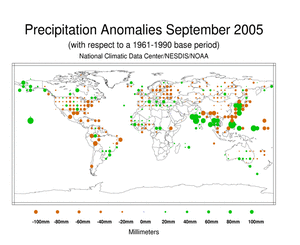Global Highlights:
|
Contents of this Section: |
| The data presented in this report are preliminary. Ranks and anomalies may change as more complete data are received and processed. The most current data may be accessed via the Global Surface Temperature Anomalies page. |
Temperature anomalies for September 2005 are shown on the two maps
below. The dot map on the left provides a spatial representation of
anomalies calculated from the Global Historical Climatology Network
(GHCN) data set of land surface stations using a 1961-1990 base
period. The map on the right is a blended product of a merged land
air and sea surface temperature anomaly analysis which is based on
data from the Global Historical Climatology Network (GHCN) of land
temperatures and the Comprehensive Ocean-Atmosphere Data Set
(COADS) of SST data. Temperature anomalies with respect to
1961-1990 are analyzed separately and then merged to form the
global analysis. Additional information on this product is available.
|
| During September 2005,
there were above average temperatures over eastern Europe, Asia,
Japan, the majority of North America and parts of Brazil. Cooler
than average temperatures were observed over France, Spain, western
Australia, central South America and along the U.S. West Coast. Much warmer than average SSTs occurred over the North Pacific and the North Atlantic. Cooler than average conditions were observed off the U.S. Californian coast and the South Atlantic. |
 larger image |
 larger image |
The mean position of upper level ridges of high pressure and troughs of low pressure (depicted by positive and negative 500 millibar height anomalies on the September 2005 map) are generally reflected by areas of positive and negative temperature anomalies at the surface, respectively. For other Global products see the Climate Monitoring Global Products page. |
| Images of sea surface temperature conditions are available for all weeks during 2005 at the weekly SST page |
|
| Current Month / Year-to-date |
| September | Anomaly | Rank | Warmest Year on Record |
|---|---|---|---|
GlobalLandOcean Land and Ocean |
+0.98°C (+1.76°F) +0.48°C (+0.86°F) +0.63°C (+1.13°F) |
warmest 3rd warmest warmest |
2nd - 1998 (+0.74°C/1.33°F) 2003 (+0.52°C/0.94°F) 2nd - 2003 (+0.57°C/1.03°F) |
Northern HemisphereLandOcean Land and Ocean |
+1.08°C (+1.94°F) +0.60°C (+1.08°F) +0.79°C (+1.42°F) |
warmest 2nd warmest warmest |
1998 (+0.80°C/1.44°F) 2003 (+0.65°C/1.17°F) 2nd - 2003 (+0.65°C/1.17°F) |
Southern HemisphereLandOcean Land and Ocean |
+0.66°C (+1.19°F) +0.43°C (+0.77°F) +0.47°C (+0.85°F) |
5th warmest 7th warmest 5th warmest |
2003 (+0.77°C/1.39°F) 1997 (+0.55°C/1.00°F) 1997 (+0.58°C/1.04°F) |
 larger image |
 larger image |
| January-September | Anomaly | Rank | Warmest Year on Record |
|---|---|---|---|
GlobalLandOcean Land and Ocean |
+0.94°C (+1.70°F) +0.44°C (+0.79°F) +0.59°C (+1.06°F) |
3rd warmest 2nd warmest 2nd warmest |
1998 (+1.04°C/1.87°F) 1998 (+0.50°C/0.90°F) 1998 (+0.66°C/1.19°F) |
Northern HemisphereLandOcean Land and Ocean |
+0.95°C (+1.71°F) +0.52°C (+0.94°F) +0.70°C (+1.26°F) |
3rd warmest warmest 2nd warmest |
2002 (+1.14°C/2.05°F) Tie - 1998 (+0.52°C/0.94°F) 1998 (+0.75°C/1.35°F) |
Southern HemisphereLandOcean Land and Ocean |
+0.77°C (+1.39°F) +0.40°C (+0.72°F) +0.47°C (+0.85°F) |
2nd warmest 4th warmest 3rd warmest |
1998 (+0.82°C/1.48°F) 1998 (+0.50°C/0.90°F) 1998 (+0.56°C/1.01°F) |
 larger image |
 larger image |
The most current data may be accessed via the Global Surface Temperature Anomalies page.
The maps below represent anomaly values based on the GHCN data set
of land surface stations using a base period of 1961-1990. During
September 2005, above average precipitation fell over Alaska,
India, Burma, Thailand, Taiwan, the U.S. northeast and lower
Mississippi Valley, and southern Brazil. Below average
precipitation was observed in Mexico, the Caribbean, Nepal, eastern
Europe, parts of southeast Asia, Bolivia and other areas of South
America, and the U.S. East Coast and Great Plains. |
 larger image |
 larger image |
|
|
Peterson, T.C. and R.S. Vose, 1997: An Overview of the Global
Historical Climatology Network Database. Bull. Amer. Meteorol.
Soc., 78, 2837-2849. |
 NOAA's National Centers for Environmental Information
NOAA's National Centers for Environmental Information

